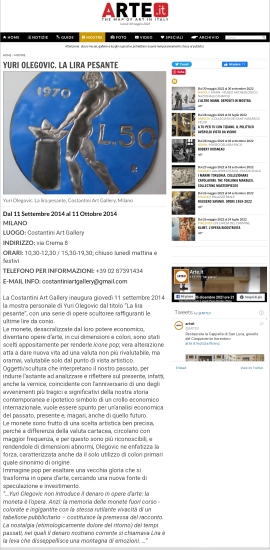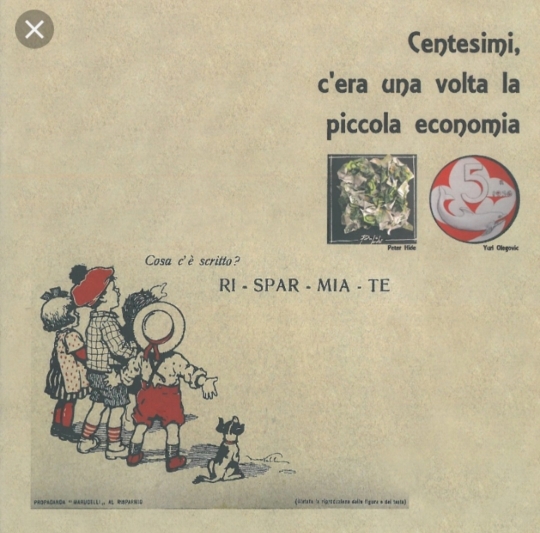Yuri Olegovic.
Color is the body of a useful memory. These works by Yuri Olegovic look back but move – straight to the point – forward.
Just what is it that makes today's homes so different, so appealing? (What exactly makes today's homes so different, so attractive?) created by Richard Hamilton in 1956 is a milestone: a measure of how much pop can enter a work of art. Hamilton's ironic collage was exhibited, also in that year, in an exhibition in London's Whitechapel Gallery entitled This Is Tomorrow.
58 years later, the shape of wellness hasn't changed much. The attractive mental landscape has renewed the reference brands, but the substance remains undisputed: the ownership of some goods will make our life worth living. Possession of the means that can be translated into goods - money - allows us to live with the possibility of renewing these goods at any time. The accumulation of money will protect us from the possibility of being able to desire what we could not possess.
“Parsimony, and not industriousness, is the immediate cause of the accumulation of capital (…) whatever industriousness may procure, if thrift did not save and set it aside, capital would never grow”. These are the words of the father of economic science Adam Smith in The Wealth of Nations. Saving money is the source of any possible well-being for individuals as well as for the state.
Why waste time with industriousness - one wonders - when we need to pay attention to thrift? In today's words, one might ask: why waste time with the real economy, when with the financial economy it is done much faster?
Yuri Olegovic does not introduce money into a work of art: the money is the work. Indeed: the memory of coins out of circulation - colored and magnified with the same glowing vivacity of an advertising billboard - constitutes the premise of the story. The nostalgia (etymologically pain of the return) of past times, in which current local money was called Lira is the lever that unearths a mountain of emotions.
We. We Italians. Us so far from the times of the economic boom. We are united in a Europe that has a single currency but speaks twenty-four languages. We who only know how to stay in a football stadium… We who inherit an enormous part of the world's artistic heritage but are unable to enhance it. We who continuously produce exhibitions, fairs and art festivals but are dominated by a market that aims at London, New York, China…
Olegovic's colorful coins/sculptures - enamels on metal - seem to contain the entire Italian identity history of these decades. But they don't stop at the pain. What is shown in these works is the possibility – which art always preserves – of overturning the landscape. What we can see is not all that our imagination contains. The most pop of icons, the "God of Money", enters the field like a Warhol's Marilyn. She dressed again. And, if Warhol maintained – wrongly, there is no doubt – that Making money is an art. Working is an art. A good deal is the best of all the arts, Olegovic ironically decrees with his money – depicting it – the defeat of that divinity. The recolored money, twice stripped of its exchange value – like an old prostitute trying to look young with greasepaint and lipstick? – try to give themselves to the world as a mere aesthetic value.
The crematistic trend of the economy – the emphasis on the multiplication of wealth regardless of its distribution and consumption as on the Stock Exchange – comes out defeated (at least ideally) by a crisis that seems to devour the future in small bites. And the progressive affirmation - very contemporary - of the most varied forms of sharing economy seems to be the beginning of a new form of civilization.
Already Aristotle, in Politics, leaned towards an economy that procures only the goods necessary to live well. Contrary to some of his contemporaries and to Solon - who supported the limitlessness of wealth - he underlined how money cannot be the beginning and the end. And he condemned usury, in which the gain comes from the exchange of money itself. Olegovic's money, enriched with color, regenerated to new life, seems to remind us of just this: the beauty of value "not in itself". The countervalue is art. And art, actually - a magnificent paradox - is priceless.
The memory of the Lira wears the color of art and returns - from the warehouses of some junk shops or from the pockets of a jacket that we haven't worn for a long time - to tell us a lot of stories. And to reveal a world of lies to us.
Francesco Tadini



EXHIBITIONS YURI OLEGOVIC.
- “Flower Uncirculated” Milan, 2021
- “Yuri Olegovic rid”, historical art exhibition, 2017
- "Lu5tro", Milano Costantini Art Gallery, from 20 April to 20 May 2017
- "Cents, once upon a time there was a small economy", Milan, Casa Museo Spazio Tadini, 2017
- "Yuri Olegovic, The heavy lira" Palermo, XXS open to the contemporary, from 18 August to 3 September 2016
- "Yuri Olegovic, The heavy lira" Milan, Costantini Art Gallery, from 11 September to 11 October 2014
- "5 lire exhibition", Milan, Casa Museo Spazio Tadini, from 7 to 13 December 2013



